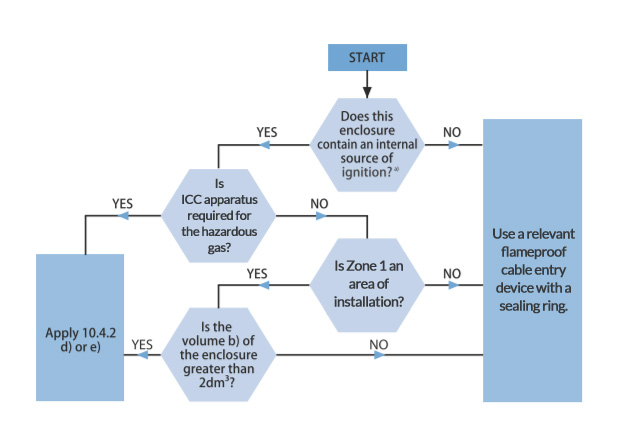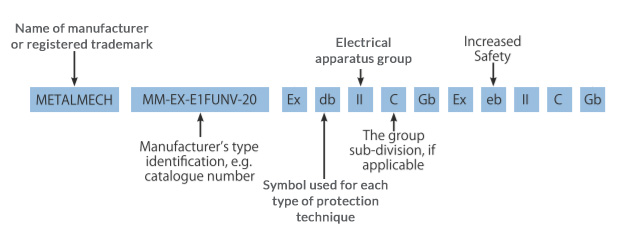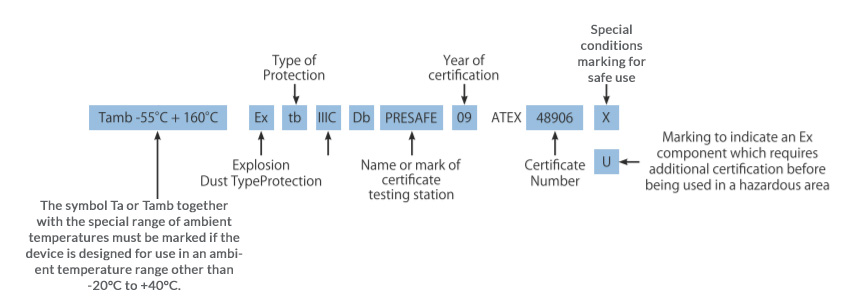ATEX Cable Glands: Explosion-proof & Flameproof (FLP) 
Metalmech’s range of Explosion-proof & Flameproof cable glands (ATEX cable glands) are accepted world-wide. With more than 15 years of experience of this field, we can provide you full technical support & information to insure safe installation of the device.
Metalmech has obtained certifications of ATEX, IECEx, EAC, CE, IP68, UKAS, NABCB, OHSAS, and RoHS, Metalmech is also awarded the Export House Status recognized by the Government of India. Ex Cable Glands available in many sizes, clamping ranges and with flat and multi cable inserts.
ATEX 2014/34/EU Directive
- European Union’s (EU) Directive 2014/34/EU are referred by the term ATEX.
- The primary purpose of the ATEX Directive is to assure the free circulation of goods inside the European Union by arranging the technical and legal needs of the Member States.
- ‘ATEX’ is the word borrowed from the French ‘Atmosphères Explosibles’.
- The ATEX Directive is defined as an approximation of the laws within the Member States concerning devices and protective systems designed to be used in possibly explosive atmospheres”.
- The ATEX Directive is focussed to cover electrical and non-electrical devices and protective systems that are designed to be used in possibly explosive atmospheres in mining and surface industries.
The Directive includes:
- Protective systems - products that control incipient explosion effects.
- Devices and products having possible source of ignition.
- Safety equipment – products having explosion safety function but are placed outside the possible explosive atmosphere.
- Components – products that form device parts or protective systems.
ATEX Directive 2014/34/EU commenced on 20th April 2016, promptly replacing the previous Directive 94/9/EC without any transition period. All the devices within its scope should comply with ATEX Directive before being put into service.
With assured consent of the Directive, devices should meet the indispensable specifications as per the Directive and should be marked with the CE marking.
The assuring process of devices adhering to the Directive, the orderliness assessment measure(s) must be complied with. These procedures may need the involvement of the Notified Body which is separate from the manufacturer and is able to assess the orderliness of the devices and the manufacturer as per the Directive. The Notified Body needs to be approved and appointed by the concerned government.
Orderliness assessment measures are inclusive of but are not limited by:
- EU Type Examination – that includes testing and inspection of relevant design of devices.
- Assured Production Quality – that includes the assessment, sporadic auditing, testing and inspection of relevant product samples as per the manufacturer’s quality policy.
- Product Verification – Every product item is inspected and/or tested for orderliness as per the EU Type Examination.
- Internal Production Control – The manufacturer should verify that the product design and each production device should comply with either harmonized European Standards or the fundamental needs or a combination of the two.
ATEX 137 Directive 99/92/EC
This ATEX Directive is focussed to cover the usage of devices in possible explosive atmosphere and it is aimed at providing minimal requirements that upgrade the safety standards and improve the health of the workers. Article 137 of Directive 89/391/EC was published in the official journal of the EC on 28th January 2000 as Directive 99/92/EC, being the 15th individual Directive of the framework Directive 89/391/EEC.
The article specifies the:
- Commitments to the employees regarding prevention and protection against explosions.
- Assessment of commitments regarding the assessment of risks of explosion.
- General commitments regarding safety and health of the worker.
- Documents need to be place regarding explosion protection in places where possible highly explosive atmosphere may appear which may endanger the health and safety of the workers. Their entry point should be marked with the signage in accordance with Section 2, Article 7 of the ATEX Directive.
Selection of Explosion-proof & FLP Cable Glands:
Select the Cable Gland that can perfectly match the diameter of the cable. Heat shrink tube, sealing tape or other materials should not be used to make the cable fit into the cable gland. The effect of “coldflow characteristic” of the cable can be reduced by carefully selecting cable glands and/or cables.
Cable Glands should be selected in accordance with IEC 60079-0 to follow the need of the protection technique as explained in a Table below.
To meet the ingress protection requirement, the cable glands need to be sealed with adaptors, blanking elements, and enclosure with the help of sealing washer or a thread sealant.
- Ignitions originated internally are inclusive of sparks or device temperatures arising during normal operation that may trigger ignition. A compartment consisting of only terminals or an indirect entry compartment is considered not to establish an internal source of ignition.
- The term ‘volume’ is defined in IEC 60079-1
- Mineral-wrapped metal-covered cable with or without plastic outer covering with suitable flameproof cable gland complying with IEC 60079;
- Flameproof sealing equipment or a sealing chamber as stated in the equipment documentation or complying with IEC 60079-1 and employing a cable gland suitable to the use of cables. The sealing equipment should include compound or other suitable seals which allow stopping around individual cores. The sealing equipment should be fitted at the point of entry cables to the device;
- Flameproof cable gland as stated in the equipment documentation or complying with IEC 60079-1, incorporate compound filled seals also known as elastomeric seals that seal around the individual cores or other similar sealing arrangements.
Selection of cable glands, adaptors and blanking elements type of protection depending on the enclosure type of protection
| Protection technique for the equipment | Glands, Adaptors and Blanking Element Protection Technique | |||
| Ex ‘d’ (See 10.6) | Ex ‘e’ (See 10.4) | Ex ‘e’ (See 10.4) | Ex ‘t’ (See 10.7) | |
| Ex ‘d’ | X | |||
| Ex ‘e’ | X | X | ||
| Ex ‘i’ and Ex ‘nL’ – Group II | X | X | X – See 16.6 | |
| Ex ‘i’ – Group IIa | X – See 16.6 | |||
- X indicates permission for use.
- a) There are no specified requirements for cable glands if only one intrinsically safe circuit is applied.
- b) Allowed only for Gc installations.
Connecting cable glands with devices
If additional clamping is required to prevent pulling and twisting of the cable transmitting the forces to the conductor terminations inside the enclosure, a clamp shall be provided, as close as practicable to the gland along the cable.
A practicable clamp will be provided if extra clamping is needed to prevent the twisting and pulling of the cable that is transferring the forces to the conductor terminations inside the enclosure.
Additionally required for entries different from Ex “d”, Ex “t” or Ex “nR”
If supplementary cable entry holes different from Ex “d”, Ex “t” or Ex “nR” are needed, following conditions are required to make them:
- They should be authorized by the manufacturer’s documentation with size of holes, area and quantity of holes.
- Plain or threaded entry holes should meet the tolerance levels mentioned by the manufacturer. Threaded holes should be kept at right angles facing the compartment. (Because of moulding methods for plastic compartments, the wall of the compartment can have angles.) Angular surfaces do not permit the cable gland and the related fittings to be inserted in the hole to fit square to the face, resulting in failed sealing. Faulty threaded holes in plastic compartments are not suggested because they create high stresses and may fracture the compartment wall during sealing of these threads.
Sealed openings
Some compartments contain just one intrinsically safe circuit. The unused opening in the compartment should be sealed by blanking elements according to the Table 10 and should maintain the degree of ingress protection IP 54 or the one needed at the location, whichever is higher. Blanking element should be of type which cannot be removed without using a tool. For flameproof compartments, use of adaptor is recommended along with the blanking elements.
Additionally required for type of protection ‘d’ – Flameproof Enclosures
In case an Ex “d” gland clamping by the sealing ring (compression) is used along with braided or armoured cable, it should be suitable for the braid or the armour which is discontinued in the gland and compression has taken place on inner cable covering. For the fine braided cables of less than 0.15 mm diameter having coverage of at least 70% compression on the outer covering is authorized.
Flameproof cable glands, along with adaptors or blanking components with parallel treads can be fitted with a sealing washer between the entry device and the flameproof compartment, provided, the applicable thread engagement should be achieved after the fitting of the washer. Minimum five full threads is called as the thread engagement. Relevant grease should be used considering it is non-seating, non-metallic and non-combustible. Proper earthing should be maintained between the two. If the taper threads are used, the connections should be made wrench tight.
To create Edition 5, during the revision of IEC 60079-14, the UK committee has proposed a few changes to the specifications relating to the selection of cable glands into Ex’d’ flameproof compartments. However, the UK committee has voted against the revision of IEC 60079-14 to create Edition 5 at both CDV and FDIS stages. IEC 60079-14:1996 Edition 2 has included a selection chart which was taken directly from BS 5345-3:1989. Subsequent editions of IEC 60079-14, up to and including Edition 4 in 2007, retained the selection chart. Edition 5, published in November 2013, has the chart that was replaced with different criteria.

Wiring Procedures for Type of Protection ‘e’ – Increased Safety
A cable gland, as a cable entry device should comply with all the specifications referred as per the suitable standard. It should be suitable to the cable type and should maintain the type ‘e’ integrity of the device.
For increased safety device a minimum ingress protection rating of IP%$ is required. It is necessary to provide a seal between the cable gland and the device to meet this requirement. As an example, a sealing washer or a thread sealant can be used. When a cable gland is fitted into a a non-metallic compartment, metallic compartment with a painted type finish or compartment with non-threaded clearance holes, additional ingress and earthing or bonding consideration is necessary. You may refer to the serrated washer, earth-tag, sealing washer, and locknut components shown in the catalogue.
Marking of Devices - IEC (Group 2)


Protection from Deluge Ingress
At offshore facilities, devices are generally located in places near emergency deluge systems. Devices that are certified for use in hazardous area are not suitable for these places. A testing procedure for electrical devices to be installed is dependent to deluge systems, also known as DTS01 which has been prepared by (ITS), the Explosion and Fire Hazards Group of ERA Technology in association with Shell UK Exploration and Production Ltd.
Testing covers:
- The devices should be charged (where applicable) for an hour before the deluge test. Then the electrical power should be disconnected before beginning the deluge test and should be resumed after an hour and should be continued until the end of deluge test.
- Performing the insulation resistance testing prior and after pre-conditioning and after the deluge test (if applicable).
- Perform pre-conditioning test by exposure to vibration and thermal ageing at 90% relative humidity and at a temperature of 20k and above. The device maximum service temperature should be at least 80°C of any applicable seals.
- Performing deluge test with a deluge chamber fitted with deluge nozzles which applies a salt water solution deluge pressure within the range of 3.5 bars to 4.5 bars at a water temperature in the range of 5°C to 10°C for about 3-hours.


